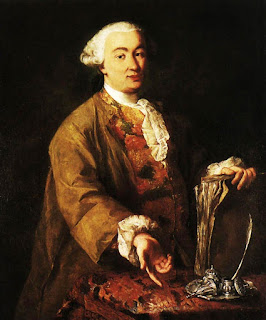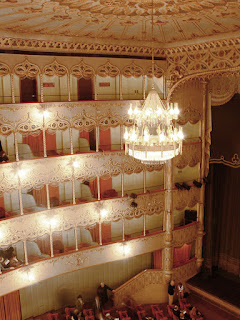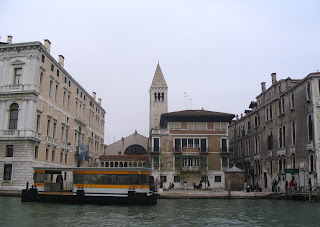Greatest Venetian dramatist whose work still entertains audiences today
 |
| Alessandro Longhi's portrait of Carlo Goldini is on display at the Casa Goldoni |
Goldoni became a prolific dramatist who reinvigorated the commedia dell’arte dramatic form by replacing its masked, stock figures with more realistic characters.
He produced tightly constructed plots with a new spirit of spontaneity and is considered the founder of Italian realistic comedy.
The son of a physician, Goldoni read comedies from his father’s library when he was young and ran away from his school at Rimini with a company of strolling players when he was just 14.
Later, while studying at the papal college in Pavia, Goldoni read comedies by Plautus, Terence and Aristophanes and learnt French so he could read plays by Molière.
He was eventually expelled for writing a satire about the ladies of Pavia and was sent to study law.
Although he practiced law in Venice and Pisa and held diplomatic appointments, his real passion was writing plays for the theatres in Venice.
 |
| Antonio Dal Zòtto's statue of Goldoni in Piazza San Bartolomeo in Venice |
In the 1750 season he produced some of his best comedies, such as I pettegolezzi delle donne - Women’s Gossip - a play in Venetian dialect, Il bugiardo - The Liar - written in commedia dell’arte style and Il vero amico - The True Friend - a comedy of manners.
From 1753 to 1762, Goldoni wrote for Teatro San Luca, now called Teatro Goldoni. Among the important plays he wrote during this period is La locandiera - Mine Hostess - which was first performed in 1753.
There was intense rivalry between competing playwrights at the time. Goldoni satirised Pietro Chiari, a rival playwright, in I malcontenti - The Malcontents - which was performed in 1755, before Carlo Gozzi, an adherent of the commedia dell’arte, denounced him in a satirical poem in 1757, then ridiculed both Goldoni and Chiari in a commedia dell’arte classic, L’amore delle tre melarance - The Love of Three Oranges - which was performed in 1761.
In 1762, Goldoni left Venice for Paris to direct the Comedie-Italienne. He later rewrote all his French plays from this period for Venetian audiences. L’Eventail, performed in France in 1763, became Il ventaglio - The Fan - and is considered one of his finest works.
Goldoni retired from the theatre in 1764 and went to teach Italian to the French royal princesses at Versailles.
In 1783 he began writing his Memoirs in French but after the French Revolution his pension was cancelled and he died in poverty in Paris in 1793. The pension was eventually restored to his widow, Nicoletta Conio, after the intervention on her behalf of the poet Andrea Chénier.
Goldoni’s most famous work, Il servitore di due padroni - The Servant of Two Masters - written in 1745, has been translated into different languages and performed many times. In 2011 it was adapted for the National Theatre in the UK under the title One Man, Two Guvnors and it was so popular it transferred to the West End and then Broadway.
Travel tip:
Goldoni was born in Ca’ Centani, or Centanni, a beautiful 15th century Gothic palace overlooking a narrow canal in the San Toma district of Venice. Better known as Casa Goldoni, the palace was bequeathed to Venice in 1931 and now houses the Goldoni Museum and a centre for theatrical studies. Through a series of displays of relics, furniture, paintings, illustrations of Goldonian comedies and explanatory panels, the museum represents the life and work of Carlo Goldoni in the context of 18th century theatre and Venetian society.
Hotels in Venice from Booking.com
Travel tip:
Teatro Goldoni near the Rialto Bridge in Venice was formerly known as Teatro San Luca, when Goldoni was writing plays for it. The present building dates back to the 1720s although it has been renovated many times after fires or structural problems. Situated in Calle Goldoni in the San Marco district, it was renamed Teatro Goldoni in 1875 and is now home to the Teatro Stabile del Veneto ‘Carlo Goldoni’.
More reading:
How Carlo Gozzi fought to preserve commedia dell'arte
Zanetta Farussi, the 18th century Venetian actress who was the mother of Casanova
Niccolò Piccinni, the opera composer for whom Goldoni wrote a libretto
Also on this day:
1682: The birth of anatomist Giovanni Battista Morgagni
1873: The birth of the great tenor Enrico Caruso
2003: The death of comic actor Alberto Sordi
Selected books:
The Comedies of Carlo Goldoni, edited and introduced by Helen Zimmern
The Servant to Two Masters, by Carlo Goldoni
Home
 |
| The interior of the Teatro Goldoni, which dates back to the 1720s |
Teatro Goldoni near the Rialto Bridge in Venice was formerly known as Teatro San Luca, when Goldoni was writing plays for it. The present building dates back to the 1720s although it has been renovated many times after fires or structural problems. Situated in Calle Goldoni in the San Marco district, it was renamed Teatro Goldoni in 1875 and is now home to the Teatro Stabile del Veneto ‘Carlo Goldoni’.
More reading:
How Carlo Gozzi fought to preserve commedia dell'arte
Zanetta Farussi, the 18th century Venetian actress who was the mother of Casanova
Niccolò Piccinni, the opera composer for whom Goldoni wrote a libretto
Also on this day:
1682: The birth of anatomist Giovanni Battista Morgagni
1873: The birth of the great tenor Enrico Caruso
2003: The death of comic actor Alberto Sordi
Selected books:
The Comedies of Carlo Goldoni, edited and introduced by Helen Zimmern
The Servant to Two Masters, by Carlo Goldoni
Home





